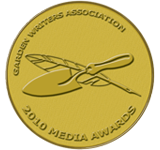My Brooklyn’s Greener Than Your Brooklyn…
July 26, 2012 by Robin Plaskoff Horton
Danna Hebbard and her Lefferts Gardens neighbor have become pals since joining forces with the rest of the block to make their’s this year’s winner in The Brooklyn Botanic Garden’s Greenest Block in Brooklyn contest. “It has brought the neighborhood together,” beamed Ms. Hebbard. “And look how great it looks! People from other blocks even go out of their way now to walk down our street.”

Danaa Hebbard and her Brooklyn neighbor bonded while greening their block.
As a second round judge of the Garden’s contest, I toured ten of the 40 semi-finalist blocks to observe containers and tree beds and more from Bay Ridge to Bedford-Stuyvesant, from Flatbush to East Flatbush, and from Lefferts Gardens and Crown Heights to my own old neighborhood, Park Slope. This year, over 200 blocks, mostly residential, entered the contest. There is a separate, smaller category open to nonprofit merchant associations.
But it’s not just great looking Hydrangeas and fabulous tree beds that determine the winner. The contest–part of BBG’s GreenBridge community environmental horticulture program that links the Garden with and offers resources to Brooklyn’s neighborhoods–is really about promoting streetscape gardening, tree stewardship, and community development by encouraging involvement and participation in greening the borough block by block.

Bed-Stuy resident and block association president emeritus poses before his block’s campaign banner.
Greenest Block contenders are a serious group. The block associations market and promote themselves in earnest, creating handmade or printed banners and sporting tee shirts. One block representative even met us with printed out talking points.

One block leader, above, shared anecdotes of community action and improvement.
As Robin Simmen, director of GreenBridge, navigated us by car (hybrid) around the borough from one neighborhood to the next, I got a good sense of what Simmen described as “ethno-botany.” Bangladeshi residents, she explained, as might be expected, grow many of the things that feature in their native cuisine such as coriander, mustard, fenugreek, and amaranth. They are also, explained Simmen, very intensive vertical gardeners, using every square inch of space and employing companion gardening techniques.
In East Flatbush, home to a large population of Caribbean descent, I observed lots of intense primary colors as well as a notably symmetrical aesthetic, which Simmen surmised might be due to an interest in maintaining visual order. The bases of all the street’s utility poles were painted yellow, as were the trash cans turned planters, below, lining both sides of the block.
On both of the East Flatbush streets I visited, there was a visible preference for colored mulch, white stones, and shiny aluminum. Residents here have also brought with them an instinctive sense for water conservation as most of the water in the Caribbean is collected through rainwater harvesting. As a result, these neighborhoods make good use of xeriscaping–gardening with little water–by cultivating many drought resistant plants. Apart from some slightly odd narrow strips of lawn sometimes used to delineate property boundaries, there was not much use of turf.
We based our judging on the contest’s specific criteria, some of which was mostly objective like maintenance, use of soil and mulching, the quality of tree beds and guards, horticultural practice (native plants receive extra points) and citizen participation. But some criteria, like creativity and color, was a bit more subjective. Although I agreed with Organic Gardening’s Managing Director, Therese Ciesinski, one of the other three judges touring with me who also did not favor colored mulch, we needed to consider this choice as part of the block’s efforts to beautify, even if it id not reflect our own taste.
Most blocks had planted containers hanging from street signs and utility poles. I particularly loved the Lefferts Gardens association’s planted watering cans, above. Wish I had seen the street last year when utility poles sported planted purses! Although hanging things from utility poles and street signs is not technically legal, Borough President Marty Markowitz, a big Greenest Block supporter, turns a blind eye to the practice.
On every block I visited, residents lobbied others to be considerate and respectful of the plants. Signs posted to trees and stuck into tree beds and containers urged dog owners to be mindful of where their pets relieved themselves with reminders that “urine kills plants.”
Residents on all the blocks appeared to care not just about their own gardens, but about their neighbors’ properties too. One person told me, “We help each other out. Some on our block are absentee landlords, so we just plant for them.”
Community engagement and collaboration on one Bedford-Stuyvesant block even extends to irrigation. Resident and president emeritus of the block association, Gary Shuford, has organized a communal watering team for which he fills a green wagon, above, in front of his brownstone with plastic jugs of water. Every few days, he and some of his neighbors pull the wagon up and down the block watering planters and tree beds.
Everyone we met along the garden contest route bubbled with excitement about the possibility of theirs becoming this year’s victorious block.
And even those without horticultural leanings, like the skateboarder above, offered only their team spirit, but nonetheless they were out and rooting for their block.
In Park Slope, residents on one small block demonstrated their collective creativity in the face of a lot of construction and a long stretch of bland gray wall, the back side of a building facing Flatbush Avenue. Together they collected and planted a variety of containers even fashioning a makeshift bench by connecting two planters with a board. It helped too that the street had their own personal benefactor, Mr. Kim, the owner of their neighborhood grocery.
One of the things I enjoyed most was experiencing the different personalities evidenced on the various blocks. While some clearly favored ornamental gardens, others showed a fondness for decoration, while a few preferred hardscaping with a minimum of ordered plantings. Still others made humble attempts to grow even a small amount of food among the flowers and shrubs. I spotted a few peach trees and a small front yard vegetable garden.
The contest, in its 18th year, is often what propels a neighborhood to form a block association, which is exactly what the BBG hopes to inspire.
The winning residential commercial block winners, who will be announced on August 8 at a press conference held on their block, will each receive $300 while all other finalists will receive cash prizes ranging from $100 to $200. The contest will also award cash prizes or gardening tools for Best Window Box, Greenest Storefront, Best Street Tree Beds, and Best Community Garden Streetscape, and all participants will be awarded a recognition certificate.
All photos: Robin Plaskoff Horton, Urban Gardens..




























 e-mail a friend
e-mail a friend


















What a great story. Three cheers for Brooklyn and everyone who lives there. Hazel
— July 27, 2012 @ 09:34
Very cool! I love the community spirit!
— July 27, 2012 @ 10:55
Love this! The power of green and the human spirit.
— July 29, 2012 @ 18:49
lowest prescription prices online india [url=https://indiamedfast.com/#]online medicine shopping in india[/url] india online pharmacy store
— March 24, 2025 @ 07:36
mexican pharmacy online order [url=https://mexicanpharminter.shop/#]reliable mexican pharmacies[/url] buying from online mexican pharmacy
— March 24, 2025 @ 16:45
Generic 100mg Easy [url=https://generic100mgeasy.shop/#]Generic100mgEasy[/url] Generic 100mg Easy
— March 26, 2025 @ 03:17
Generic 100mg Easy [url=https://generic100mgeasy.com/#]buy generic 100mg viagra online[/url] Generic 100mg Easy
— March 26, 2025 @ 12:56
Generic 100mg Easy [url=https://generic100mgeasy.com/#]Generic100mgEasy[/url] buy generic 100mg viagra online
— March 26, 2025 @ 22:44
Generic 100mg Easy [url=http://generic100mgeasy.com/#]Generic 100mg Easy[/url] Generic100mgEasy
— March 27, 2025 @ 10:33
buy generic 100mg viagra online [url=http://generic100mgeasy.com/#]viagra without prescription[/url] generic sildenafil
— March 27, 2025 @ 22:00
buy generic 100mg viagra online [url=https://generic100mgeasy.shop/#]Generic100mgEasy[/url] viagra canada
— March 28, 2025 @ 09:28
TadalafilEasyBuy.com [url=https://tadalafileasybuy.shop/#]Generic Cialis without a doctor prescription[/url] Tadalafil Easy Buy
— March 28, 2025 @ 20:30
kamagra gel kopen [url=https://kamagrakopen.pro/#]Kamagra[/url] kamagra pillen kopen
— March 29, 2025 @ 10:46
cialis without a doctor prescription [url=https://tadalafileasybuy.com/#]cialis without a doctor prescription[/url] cialis without a doctor prescription
— March 30, 2025 @ 00:34
cheapest viagra [url=http://generic100mgeasy.com/#]buy generic 100mg viagra online[/url] Generic100mgEasy
— March 30, 2025 @ 11:57
cialis without a doctor prescription [url=https://tadalafileasybuy.com/#]TadalafilEasyBuy.com[/url] TadalafilEasyBuy.com
— March 30, 2025 @ 23:30
online apotheek [url=http://apotheekmax.com/#]ApotheekMax[/url] Betrouwbare online apotheek zonder recept
— March 31, 2025 @ 09:11
Kamagra Gel [url=https://kamagrapotenzmittel.com/#]kamagra[/url] Kamagra Oral Jelly
— March 31, 2025 @ 18:31
Kamagra kaufen ohne Rezept [url=https://kamagrapotenzmittel.shop/#]kamagra[/url] kamagra
— April 1, 2025 @ 05:14
apotek online recept [url=https://apotekonlinerecept.com/#]Apoteket online[/url] Apotek hemleverans recept
— April 1, 2025 @ 16:30
ed meds online canada [url=https://gocanadapharm.shop/#]onlinecanadianpharmacy[/url] best online canadian pharmacy
— April 3, 2025 @ 12:56
best canadian online pharmacy [url=https://gocanadapharm.com/#]www canadianonlinepharmacy[/url] maple leaf pharmacy in canada
— April 3, 2025 @ 22:34
reputable indian online pharmacy [url=http://wwwindiapharm.com/#]indian pharmacies safe[/url] www india pharm
— April 4, 2025 @ 23:07
canadian neighbor pharmacy [url=https://gocanadapharm.shop/#]go canada pharm[/url] buying drugs from canada
— April 5, 2025 @ 10:49
indian pharmacies safe [url=http://wwwindiapharm.com/#]indianpharmacy com[/url] india online pharmacy
— April 5, 2025 @ 22:15
AmOnlinePharm [url=http://amonlinepharm.com/#]AmOnlinePharm[/url] AmOnlinePharm
— April 6, 2025 @ 06:58
Clom Fast Pharm [url=http://clomfastpharm.com/#]Clom Fast Pharm[/url] Clom Fast Pharm
— April 6, 2025 @ 16:58
lisinopril 10 mg online [url=https://lisinexpress.shop/#]buy cheap lisinopril 40 mg no prescription[/url] Lisin Express
— April 7, 2025 @ 03:09
90 lisinopril [url=https://lisinexpress.com/#]cost for 40 mg lisinopril[/url] lisinopril 20 mg discount
— April 7, 2025 @ 15:58
Pred Pharm Net [url=https://predpharmnet.com/#]prednisone 0.5 mg[/url] Pred Pharm Net
— April 8, 2025 @ 04:15
AmOnlinePharm [url=http://amonlinepharm.com/#]AmOnlinePharm[/url] amoxicillin 250 mg capsule
— April 8, 2025 @ 17:26
sweet bonanza oyna [url=https://sweetbonanza1st.shop/#]sweet bonanza yorumlar[/url] sweet bonanza yorumlar sweetbonanza1st.com
— April 9, 2025 @ 05:05
sweet bonanza yorumlar [url=https://sweetbonanza1st.com/#]sweet bonanza siteleri[/url] sweet bonanza slot sweetbonanza1st.com
— April 9, 2025 @ 15:07
casino siteleri [url=https://casinositeleri1st.shop/#]deneme bonusu veren siteler[/url] deneme bonusu veren siteler casinositeleri1st.shop
— April 10, 2025 @ 01:17
sweet bonanza giris [url=http://sweetbonanza1st.com/#]sweet bonanza oyna[/url] sweet bonanza demo sweetbonanza1st.com
— April 10, 2025 @ 13:20
sweet bonanza giris [url=https://sweetbonanza1st.shop/#]sweet bonanza oyna[/url] sweet bonanza oyna sweetbonanza1st.com
— April 11, 2025 @ 01:28
deneme bonusu veren siteler casino [url=https://casibom1st.shop/#]casibom guncel adres[/url] slot bonus casibom1st.shop
— April 11, 2025 @ 13:44
mexican pharmacy [url=https://usmexpharm.shop/#]mexican pharmacy[/url] USMexPharm
— April 12, 2025 @ 01:47
Us Mex Pharm [url=https://usmexpharm.shop/#]UsMex Pharm[/url] UsMex Pharm
— April 12, 2025 @ 11:12
mexican pharmacy [url=https://usmexpharm.com/#]Mexican pharmacy ship to USA[/url] UsMex Pharm
— April 12, 2025 @ 20:27
usa mexico pharmacy [url=https://usmexpharm.com/#]usa mexico pharmacy[/url] usa mexico pharmacy
— April 13, 2025 @ 07:37
mexican pharmacy [url=https://usmexpharm.com/#]Mexican pharmacy ship to USA[/url] USMexPharm
— April 13, 2025 @ 20:02
USA India Pharm [url=http://usaindiapharm.com/#]UsaIndiaPharm[/url] UsaIndiaPharm
— April 14, 2025 @ 07:32
?»?legitimate online pharmacies india [url=https://usaindiapharm.com/#]top online pharmacy india[/url] indianpharmacy com
— April 14, 2025 @ 17:37
UsaIndiaPharm [url=http://usaindiapharm.com/#]buy prescription drugs from india[/url] india online pharmacy
— April 15, 2025 @ 04:36
indian pharmacy [url=https://usaindiapharm.shop/#]india pharmacy[/url] USA India Pharm
— April 15, 2025 @ 16:35
USA India Pharm [url=http://usaindiapharm.com/#]UsaIndiaPharm[/url] USA India Pharm
— April 16, 2025 @ 16:36
?»?legitimate online pharmacies india [url=https://usaindiapharm.shop/#]USA India Pharm[/url] UsaIndiaPharm
— April 17, 2025 @ 04:42
usa canada pharm [url=https://usacanadapharm.com/#]usa canada pharm[/url] USACanadaPharm
— April 17, 2025 @ 13:06
canadian pharmacies compare [url=https://usacanadapharm.com/#]USACanadaPharm[/url] safe canadian pharmacies
— April 17, 2025 @ 21:46
canadian pharmacy king [url=http://usacanadapharm.com/#]canadian pharmacy 365[/url] canadian neighbor pharmacy
— April 19, 2025 @ 20:56
[url=https://olympecasino.pro/#]olympe casino cresus[/url] olympe casino cresus
— April 20, 2025 @ 08:22
[url=https://olympecasino.pro/#]olympe casino avis[/url] olympe casino en ligne
— April 20, 2025 @ 11:45
[url=https://olympecasino.pro/#]olympe[/url] olympe casino en ligne
— April 20, 2025 @ 17:43
[url=https://olympecasino.pro/#]olympe casino en ligne[/url] olympe
— April 21, 2025 @ 03:34
[url=https://olympecasino.pro/#]olympe[/url] olympe
— April 21, 2025 @ 16:30
[url=https://olympecasino.pro/#]olympe casino en ligne[/url] olympe casino cresus
— April 21, 2025 @ 19:42
[url=https://olympecasino.pro/#]olympe casino avis[/url] olympe
— April 21, 2025 @ 23:04
[url=https://olympecasino.pro/#]olympe[/url] olympe casino en ligne
— April 22, 2025 @ 15:02
[url=https://olympecasino.pro/#]casino olympe[/url] casino olympe
— April 22, 2025 @ 21:18
[url=https://olympecasino.pro/#]olympe casino cresus[/url] olympe
— April 23, 2025 @ 00:21
[url=https://olympecasino.pro/#]olympe casino[/url] casino olympe
— April 23, 2025 @ 03:27
[url=https://olympecasino.pro/#]olympe casino cresus[/url] casino olympe
— April 23, 2025 @ 15:48
Tadalafil achat en ligne [url=https://tadalmed.shop/#]Cialis sans ordonnance pas cher[/url] Tadalafil sans ordonnance en ligne tadalmed.com
— April 23, 2025 @ 23:32
pharmacies en ligne certifi?©es [url=http://pharmafst.com/#]Meilleure pharmacie en ligne[/url] pharmacie en ligne sans ordonnance pharmafst.shop
— April 24, 2025 @ 02:52